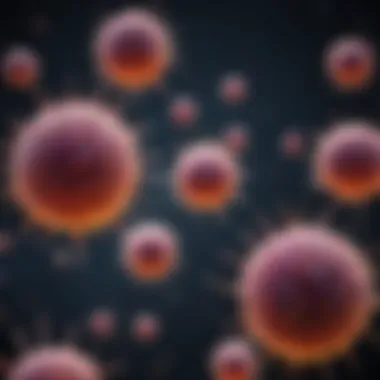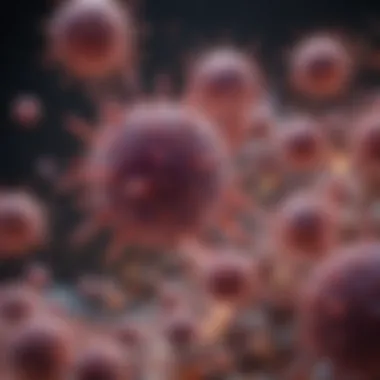T Cell Infiltration in Tumors: Mechanisms and Implications


Intro
The infiltration of T cells into tumors is a cornerstone of cancer immunology. Understanding how T cells operate within the tumor microenvironment reveals critical insights into tumor behavior and patient outcomes. Research has shown that T cell presence often correlates with improved survival rates in various cancers. Yet, the mechanisms regulating T cell infiltration are complex and multifaceted. Examining these mechanisms provides a deeper understanding of immune evasion and tumor progression. This foundation is vital for developing new therapies aimed at enhancing immune responses against tumors. The implications of T cell infiltration extend beyond statistics; they delve into the very mechanisms that govern tumor biology.
Research Highlights
Overview of Key Findings
- Diverse T Cell Subtypes: Different types of T cells, including CD4+ and CD8+ cells, play unique roles in immune response. CD8+ T cells are often referred to as cytotoxic T lymphocytes, which directly attack tumor cells.
- Tumor Microenvironment: The tumor microenvironment influences T cell behavior significantly. Factors such as tumor-derived immunosuppressive signals can hinder T cell activation and survival.
- Prognostic Implications: High levels of T cell infiltration are generally associated with better prognosis in several cancer types. For instance, studies indicate that patients with high CD8+ T cell counts in their tumors often exhibit longer survival.
- Therapeutic Approaches: Emerging therapies are focusing on enhancing T cell activation and penetration into tumors, such as immune checkpoint inhibitors and adoptive cell transfer therapies.
Significance of the Research
The research surrounding T cell infiltration is paramount. Not only does it provide insights into the fundamental biology of tumors, but it also informs therapeutic strategies. By understanding how T cells engage with tumors, researchers can develop interventions that potentially reinvigorate anti-tumor immunity. This knowledge is essential for oncologists and researchers who grapple with treatment resistance and the intricacies of tumor immunity.
"T cell infiltration in tumors is not merely a marker of immune activity; it is a dynamic process that shapes the outcome of cancer therapy."
Original Research Articles
Summary of the Article
The discussion around T cell infiltration in tumors reveals vital mechanisms that underpin immune responses in cancer. Various studies have laid the groundwork for identifying how T cells migrate to tumors, survive and operate once they arrive. These findings are not only theoretical but have clinical implications, as they directly inform treatment strategies.
Author Contributions
The contributions by different authors within this field emphasize the collaborative nature of cancer research. Various experts in immunology, oncology, and molecular biology contribute to the accumulating body of knowledge regarding T cell behavior in tumors. Their collective work furthers our understanding and drives innovation in cancer therapies.
Preamble to T Cell Infiltration
T cell infiltration into tumors represents a pivotal aspect of cancer immunology. Understanding how T cells migrate into the tumor microenvironment enhances our insight into tumor biology and the immune system's response to malignancies. The presence or absence of T cells can greatly influence tumor progression, treatment outcomes, and patient survival. Thus, studying T cell infiltration is crucial for developing targeted therapies that can effectively manipulate the immune response to eradicate tumor cells.
Definition of T Cell Infiltration
T cell infiltration refers to the entry of T lymphocytes, a critical component of the adaptive immune system, into tumor tissues. T cells serve various roles, including directly killing cancerous cells, supporting other immune cells, and maintaining immune memory. This infiltration indicates an active immune response against the tumor, which can be a double-edged sword. While T cell presence often correlates with a favorable prognosis, tumor cells can also develop mechanisms to evade immune detection and suppression. Therefore, defining the nature and extent of T cell infiltration is essential for both prognostic evaluation and therapeutic strategizing.
Historical Overview
Historically, the link between T cell infiltration and tumor immunity has evolved significantly. In the early studies of carcinogenesis, the immune system was often seen as a passive observer of tumor growth. However, groundbreaking research in the 1980s unveiled the crucial roles of immune cells, particularly T cells, in surveilling and combating tumors. The discovery of tumor-infiltrating lymphocytes (TILs) led to heightened interest in understanding their capacity to predict clinical outcomes.
In the late 20th century, advancements in immunotherapy further underscored the significance of T cell activity in malignancies. Pioneering works, such as those related to cytokine therapy and monoclonal antibodies, exemplified how harnessing T cells could modify tumor behavior. Today's exploration of immune checkpoint inhibitors and cell-based therapies, like CAR T cells, has its roots in the foundational research concerning T cell infiltration into tumors.
Types of T Cells in Tumors
Understanding the different types of T cells in tumors is essential for comprehending their roles and influences on cancer progression. T cells are a critical part of the immune system, and their infiltration into tumor microenvironments can indicate various pathways of immune response, ultimately impacting cancer prognosis and therapies. Each subset of T cells plays distinct functions that contribute to either the activation or suppression of immune responses against tumors. Given the complexity of tumor biology, recognizing how different T cell types interact with cancer cells, other immune cells, and the surrounding environment fosters a deeper insight into potential therapeutic avenues.
Cytotoxic T Lymphocytes
Cytotoxic T lymphocytes (CTLs), often referred to as CD8+ T cells, play a pivotal role in directly targeting and destroying cancer cells. These T cells recognize specific antigens presented on the surface of tumor cells through Major Histocompatibility Complex (MHC) class I molecules. When CTLs identify these tumor-associated antigens, they initiate apoptosis in the cancer cells, thereby limiting tumor growth.
The importance of CTLs in tumor infiltration is underscored by their correlation with favorable patient outcomes. High densities of CD8+ T cells within tumors often correlate with increased survival rates and positive responses to immune checkpoint inhibitors. Understanding the mechanisms that enable the effective infiltration and activation of CTLs can lead to improved immunotherapeutic strategies.
Helper T Cells
Helper T cells, primarily classified as CD4+ T cells, assist in modulating and enhancing the immune response. These cells do not directly kill tumor cells; instead, they coordinate the actions of other immune cells, including CTLs and B cells. By producing a variety of cytokines, helper T cells influence the immune landscape of the tumor microenvironment.
Different subtypes of helper T cells, such as T, T, and T7, have distinct roles. For instance, T cells are crucial for promoting CTL activity, while T cells play roles in humoral immunity. The balance between these helper cell subsets can significantly affect the immune response to tumors. Research shows that a T-dominated response is generally favorable for combating tumors, highlighting the necessity to understand helper T cells further in cancer immunology.
Regulatory T Cells
Regulatory T cells (Tregs) have a contrasting role in tumor immunity. These cells, primarily characterized by the expression of CD4 and Forkhead box P3 (FOXP3), are essential for maintaining immune tolerance and preventing excessive immune responses that could damage healthy tissue. However, their presence within tumors often correlates with poor prognoses because Tregs can suppress the antitumor activity of CTLs and helper T cells.
Mechanisms of action for Tregs include the secretion of immunosuppressive cytokines, such as IL-10 and TGF-β, which further inhibits the activity of effector T cells. As a result, the balance between regulatory and effector T cells within the tumor microenvironment is crucial. Targeting Tregs may represent a potential strategy in cancer therapy, as diminishing their suppression could enhance the effectiveness of antitumor immune responses.


In summary, the roles of cytotoxic T lymphocytes, helper T cells, and regulatory T cells within tumors are distinct yet interconnected. A thorough understanding of these T cell types provides a crucial foundation for developing novel immunotherapies aimed at enhancing the body’s immune response against cancer.
Mechanisms of T Cell Infiltration
Understanding the mechanisms of T cell infiltration is crucial in the realm of oncology. This knowledge can profoundly affect therapeutic strategies and outcomes. T cells, essential components of the immune system, are responsible for identifying and destroying cancer cells. Their infiltration into tumors signifies potential for effective immune response. However, not all tumors allow for beneficial T cell responses. Multiple factors can influence this process.
Key mechanisms at play include chemokine signaling, cellular adhesion molecules, and tumor strategies for immune evasion. Each of these elements plays a significant role in determining how well T cells can infiltrate and function within the tumor environment. Understanding these mechanisms enables researchers and clinicians to innovate new ways to enhance T cell responses, ultimately improving cancer treatment efficacy.
Chemokine Signaling
Chemokines are small signaling proteins crucial for the migration of T cells towards inflamed tissues. They act by binding to specific receptors on T cells, guiding them through the extracellular environment toward tumor sites. The effectiveness of chemokine signaling can vary widely depending on the type of tumor and its microenvironment. Many tumors produce specific chemokines that may either attract T cells or inhibit their recruitment.
The balance of chemokines present in the tumor microenvironment can heavily influence the extent of T cell infiltration. For instance, tumors secreting high levels of pro-inflammatory chemokines tend to promote a robust immune response, leading to increasing infiltration of effector T cells. Conversely, tumors that express anti-inflammatory chemokines can suppress T cell activity, hampering effective immune responses.
Cellular Adhesion Molecules
Cellular adhesion molecules (CAMs) are crucial in facilitating T cell binding to endothelial cells and subsequently migrating through blood vessels into tumor tissues. These molecules play a variety of roles in signaling and adhesion processes essential for T cell trafficking. In the absence of proper adhesion signals, T cells may fail to localize to tumor sites.
Different types of CAMs, such as selectins and integrins, contribute to T cell positioning. Changes in tumor-associated vascular structures can influence these interactions. Tumors with impaired CAM expression may escape immune surveillance due to reduced T cell infiltration, which is a challenge in cancer therapy.
Immune Evasion Strategies by Tumors
Downregulation of Antigen Presentation
Tumors have evolved various strategies to escape immune detection. One prominent strategy includes the downregulation of antigen presentation. This occurs when tumor cells reduce the expression of major histocompatibility complex (MHC) molecules, which are crucial for presenting tumor antigens to T cells. As a result, T cells may not recognize tumor cells as threats.
This characteristic is detrimental as it allows tumor cells to evade immune recognition effectively. The downregulation of antigen presentation is appealing for this discussion as it highlights a unique tumor adaptation that directly affects T cell infiltration. A well-studied aspect includes the potential for increased immune tolerance, where the immune system fails to mount an effective response due to a lack of target recognition.
Secretion of Immunosuppressive Factors
Another critical immune evasion strategy is the secretion of immunosuppressive factors by tumors. These factors, which may include cytokines like interleukin-10 or transforming growth factor-beta (TGF-β), create a suppressive microenvironment. They inhibit T cell activation and proliferation, thus limiting the efficacy of T cell responses within the tumor.
The unique feature of this mechanism lies in its ability to create a barrier that negatively impacts the function of infiltrating T cells. Immunosuppressive factors present a dual challenge: they directly inhibit T cell activation and indirectly foster an environment that favors tumor growth. Understanding this dynamic is essential for developing therapies that counteract these suppressive signals and rejuvenate T cell activity.
T Cell Infiltration and Tumor Microenvironment
The interaction of T cell infiltration within the tumor microenvironment is a pivotal area of study in cancer immunology. Understanding this relationship sheds light on how tumors can either promote or inhibit immune responses, impacting tumor progression and patient outcomes. The tumor microenvironment, comprising various cellular and non-cellular components, is crucial in determining the efficacy of T cell responses against malignancies.
Interactions with Cancer Cells
T cells do not operate in isolation; their behavior is heavily influenced by the surrounding cancer cells. When T cells infiltrate a tumor, they engage directly with cancer cells through antigen recognition, which can lead to cytotoxic activity. However, cancer cells can develop mechanisms to evade this immune attack. For instance, they may downregulate major histocompatibility complex (MHC) molecules, preventing T cell recognition.
Moreover, the secretion of immunosuppressive cytokines by cancer cells can inhibit T cell activation. Tumors may also release soluble factors that promote T cell exhaustion, a state where T cells lose their functional capacity over time. A deeper understanding of these interactions is essential as it may guide the development of therapies aimed at enhancing T cell efficacy against tumor cells.
Role of Tumor-Associated Macrophages
Tumor-associated macrophages (TAMs) are integral players within the tumor microenvironment. These cells are derived from the monocyte lineage and often exhibit an alternative activation state that supports tumor growth and immune evasion. TAMs can produce various cytokines and growth factors that can either promote or suppress T cell activity.
In a tumor setting, there can be a paradoxical relationship between T cells and TAMs. While T cells seek to eliminate tumor cells, TAMs can dampen their activity by secreting immunosuppressive factors. The presence of TAMs is often correlated with poor prognosis in several cancers. Thus, understanding the dynamics between T cells and TAMs is crucial, as targeting TAMs may enhance T cell function and improve therapeutic outcomes.
Impact of Extracellular Matrix
The extracellular matrix (ECM) is another vital component of the tumor microenvironment, providing structural and biochemical support to surrounding cells. The composition and remodeling of the ECM can significantly influence T cell infiltration and functionality. A dense ECM can act as a physical barrier, preventing T cell movement within the tumor.
Additionally, the stiffness and organization of the ECM can affect T cell activation and persistence. For instance, altered ECM components may influence the migration patterns of T cells, potentially leading to insufficient immune responses. Analyzing the impact of ECM on T cell behavior is crucial as it opens up avenues for modifying the tumor microenvironment to facilitate better T cell accessibility and effectiveness in targeting tumors.
Understanding how T cells interact with the tumor microenvironment is essential for developing new strategies to enhance anti-tumor immunity.
Role of T Cell Infiltration in Cancer Outcomes
T cell infiltration within tumors significantly influences cancer outcomes. This section examines the impact of T cell presence in tumor microenvironments and highlights its relationship with various factors such as prognosis, survival rates, and tumor recurrence. Understanding these aspects is crucial for researchers and clinicians working in immuno-oncology, as they provide insights into the effectiveness of therapeutic strategies.
Prognostic Indicators


Prognostic indicators often guide treatment decisions. T cell infiltration has emerged as a key prognostic factor in numerous cancers. Studies show that higher levels of cytotoxic T lymphocytes correlate with better patient outcomes. In specific tumor types, such as melanoma and breast cancer, the presence of T cells can indicate a more favorable prognosis.
Some important factors include:
- The density of infiltrated T cells in tumor regions.
- The ratio of effector T cells to regulatory T cells.
- The expression of activation markers on T cells, indicating their functionality.
Research indicates that a robust T cell response may help control tumor growth and aid in the elimination of malignant cells. For instance, a study highlighted that patients with high T cell infiltration experienced longer overall survival compared to those with low levels. This relationship underscores the potential of T cells as critical determinants for tailoring immunotherapies.
Correlation with Survival Rates
The correlation between T cell infiltration and survival rates suggests profound implications for cancer treatment approaches. Higher levels of effector T cells, particularly CD8+ cytotoxic T cells, are generally associated with improved survival rates. This correlation exists across various cancers, suggesting T cells may play a universal role in anti-tumor immunity.
In terms of statistical significance:
- Increased survival rates have been observed in various cancers, including colorectal and lung cancers.
- Meta-analyses often demonstrate that those with T cell-rich tumors experience a statistically significant improvement in five-year survival rates.
The importance of T cell responses reinforces the need to design therapies that foster a strong cytotoxic T cell presence. Enhancing the recruitment and activation of these critical immune cells can lead to more effective treatment outcomes.
Influence on Tumor Recurrence
Tumor recurrence presents a significant challenge in cancer management. T cell infiltration appears to play a dual role in this aspect. While active T cell responses can reduce the initial tumor burden, their presence alone does not guarantee long-term tumor control.
Factors that may influence tumor recurrence include:
- The functional state of infiltrating T cells, as exhausted T cells lose their capacity to eliminate tumor cells.
- The tumor microenvironment, which might alter T cell functionality and promote immunosuppressive signals.
- The presence of regulatory T cells that can inhibit effector T cell responses.
Research indicates that a robust T cell response can lead to prolonged disease-free survival. Nevertheless, the heterogeneity of tumors complicates the consistent relationship between T cell infiltration and recurrence rates. Ongoing studies aim to elucidate these complexities to develop strategies that minimize recurrence following successful treatments.
In summary, T cell infiltration affects cancer outcomes in multiple ways. It serves as a vital prognostic indicator, correlates with survival rates, and influences recurrence risk. By understanding these dynamics, the field of immuno-oncology can advance towards effective therapeutic strategies.
Therapeutic Implications of T Cell Infiltration
T cell infiltration into tumors presents significant therapeutic implications. The ability of T cells to penetrate and act within the tumor microenvironment influences treatment avenues and patient outcomes. Understanding how to harness these immune cells can be key in developing effective cancer treatments.
The focus on T cell infiltration leads to innovative approaches in immunotherapy. These therapies aim to enhance the activity of T cells within tumors, promoting anti-tumor responses. By enhancing T cell responses, it is possible to improve patient prognosis and develop more personalized treatment strategies.
Immune Checkpoint Inhibitors
Immune checkpoint inhibitors represent a pivotal advancement in cancer therapy. These agents work by blocking proteins that prevent T cells from attacking cancer cells. By removing these inhibitory signals, T cells can become activated and infiltrate tumors more effectively.
Commonly used immune checkpoint inhibitors include Pembrolizumab and Nivolumab. They target the PD-1 receptor, a critical checkpoint in tumor immune evasion. Clinical trials have demonstrated promising results, leading to significant survival benefits in patients with melanoma and non-small cell lung cancer, among others. However, response rates can vary significantly among individuals which makes ongoing research essential.
Adoptive Cell Therapy
Adoptive cell therapy involves the transfer of T cells into patients to enhance anti-tumor activity. This method can be tailored to reflect a patient’s unique tumor profile, making it a personalized approach to cancer treatment.
CAR T Cell Therapy
Chimeric Antigen Receptor (CAR) T cell therapy is a notable form of adoptive cell therapy that uses genetically engineered T cells. The key characteristic of CAR T cell therapy is its ability to specifically target and destroy cancer cells expressing particular antigens. This targeted approach has shown remarkable results in hematologic malignancies,
such as certain types of leukemia and lymphoma. The unique feature of CAR T cell therapy is its adaptability. It allows T cells to recognize and attack cancer cells more effectively, leading to potentially long-lasting responses. However, challenges such as severe adverse events, including cytokine release syndrome, have been reported and require careful management.
TCR Therapy
T cell receptor (TCR) therapy is another form of adoptive cell therapy. It harnesses T cells that are engineered to recognize specific tumor antigens presented by major histocompatibility complex (MHC) molecules on cancer cells. TCR therapy is beneficial as it can target a wider range of tumors than CAR T cell therapy, especially solid tumors.
However, this therapy faces challenges, particularly in identifying the right antigens and ensuring T cell activity in the immunosuppressive tumor microenvironment. Considerable research is underway to refine these therapies to enhance their effectiveness and safety.
Vaccination Strategies
Vaccination strategies are also emerging as a promising approach to stimulate T cell infiltration. Cancer vaccines aim to enhance the immune system's recognition of tumor-specific antigens. These strategies can potentially improve T cell responses, thereby promoting infiltration into tumors.


Challenges in Harnessing T Cell Responses
Understanding the challenges related to T cell responses is crucial in the context of tumor immunology. T cells play a significant role in the antitumor immune response. However, several challenges can limit their effectiveness in eliminating cancer cells. Addressing these challenges may enhance the efficacy of current and future cancer therapies.
T Cell Exhaustion
T cell exhaustion is a well-documented phenomenon that occurs during chronic stimulation of T cells, especially in the tumor microenvironment. This state is characterized by the progressive loss of T cell function and an increased expression of inhibitory receptors like PD-1 and CTLA-4. When T cells encounter persistent antigen exposure, such as from tumor antigens, they become less effective at mounting an immune response. This is concerning because exhausted T cells can no longer effectively eliminate cancer cells, allowing tumors to grow and spread.
There are several factors contributing to T cell exhaustion:
- Chronic antigen stimulation: Continuous exposure to tumor antigens can lead to sustained T cell activation, pushing them into an exhausted state.
- Immunosuppressive tumor microenvironment: Tumors may create an environment rich in immunosuppressive factors, such as cytokines and regulatory T cells, further promoting T cell exhaustion.
- Metabolic dysregulation: Exhausted T cells often display altered metabolism, impacting their survival and functionality.
Efforts to reverse T cell exhaustion are underway. Strategies include targeting the inhibitory pathways through immune checkpoint inhibitors or combining therapies that enhance T cell function while reducing inhibitory signals.
Tumor Heterogeneity
Tumor heterogeneity refers to the presence of a diverse population of cancer cells within a single tumor or across different tumors in one patient. This heterogeneity can manifest in various forms, such as genetic, phenotypic, and microenvironmental variations. Such diversity poses significant challenges when trying to harness T cell responses effectively.
The implications of tumor heterogeneity for T cell responses include:
- Variability in antigen expression: Not all tumor cells may express the same antigens. A T cell response initiated against a specific antigen may not be effective if tumor cells downregulate that antigen.
- Influence on T cell infiltration: Some subpopulations of cancer cells may produce factors that inhibit T cell migration into tumors, creating an immunologically hostile environment.
- Resistance to therapies: Heterogeneous tumors may exhibit different responses to therapies, including immunotherapies. This unpredictability can complicate treatment strategies.
Combating tumor heterogeneity requires personalized approaches in therapy. For example, identifying specific tumor antigens that vary among cells can be critical for developing targeted treatments.
"Understanding T cell exhaustion and tumor heterogeneity represents a major leap toward effective immuno-oncology strategies. Addressing these challenges may increase treatment success rates and improve patient outcomes."
Future Directions in T Cell-Related Research
Research on T cell infiltration in tumors is at a pivotal juncture, offering numerous avenues for future exploration. Emerging insights into the complex interactions between T cells and tumor microenvironments can greatly enhance our understanding of cancer biology. This section focuses on personalized immunotherapy and novel biomarkers. Both topics are crucial for developing bespoke treatment strategies and improving patient outcomes.
Personalized Immunotherapy
Personalized immunotherapy represents a tailored approach to cancer treatment. This strategy utilizes the specific characteristics of a patient's tumor to design effective interventions. By analyzing the tumor's unique antigens, researchers can create therapies that harness the patient's immune system more meticulously.
Key advancements in this area include the development of neoantigen-targeted therapies. These therapies focus on the unique mutations found in individual tumors. One benefit of personalized immunotherapy is its potential to minimize off-target effects.
Furthermore, integrating genetic profiling with T cell responses can lead to more successful outcomes.
- Antigen Identification: Understanding which neoantigens are presented on tumor cells aids the development of vaccines or adoptive cell transfer therapies.
- Immune Monitoring: Continual assessment of T cell activity enables prompt adjustments in treatment based on patient response.
- Combination Therapies: Merging personalized immunotherapy with traditional treatments may produce synergistic effects, enhancing overall efficacy.
Novel Biomarkers
The identification of novel biomarkers is essential for monitoring T cell responses in tumors. Biomarkers provide valuable insights into the tumor's mutation status and the immune landscape. They help clinicians determine the prognosis and tailor therapeutic interventions effectively.
Some promising areas include:
- Tumor Mutational Burden (TMB): TMB can gauge the total number of mutations in a tumor. A higher TMB often correlates with a better response to immunotherapies.
- Immune Infiltrate Characterization: Assessing the types and states of immune cells within the tumor can predict treatment efficacy and track progress.
- Circulating Tumor DNA (ctDNA): Analyzing ctDNA can reveal real-time changes in tumor characteristics, allowing for agile treatment adjustments.
The rise of precision medicine underscores the importance of integrating novel biomarkers to refine cancer care.
In summation, future research in personalized immunotherapy and novel biomarkers holds substantial promise for improving T cell infiltration effectiveness in tumors. By targeting these areas, we can advance oncological care towards more customized and targeted approaches.
Finale
The conclusion serves as a pivotal component in understanding the multifaceted role of T cell infiltration in tumors. In this article, we have explored various aspects, including mechanisms, types of T cells, and their implications for cancer prognosis and therapy. Each of these elements contributes to a comprehensive framework for assessing how T cells interact with tumors, influencing treatment outcomes.
Summary of Key Findings
The examination of T cell infiltration reveals several key findings:
- Diverse T Cell Populations: Different types of T cells, including cytotoxic T lymphocytes and regulatory T cells, play unique roles in tumor environments. Their interactions determine tumor progression and immune response.
- Mechanisms of Infiltration: We uncovered various mechanisms driving T cell infiltration, such as chemokine signaling and adhesion molecules. Tumors can exploit these mechanisms to evade immune responses.
- Impact on Outcomes: The level of T cell infiltration correlates significantly with patient outcomes, acting as a prognostic indicator. A greater presence of effector T cells often correlates with improved survival rates, while regulatory T cells may be associated with poorer outcomes.
- Therapeutic Strategies: The article highlighted innovative therapeutic strategies leveraging T cell activity, including immune checkpoint inhibitors and adoptive cell therapies, which demonstrate promise in enhancing anti-tumor responses.
Implications for Future Oncological Research
Future research must continue to investigate the intricacies of T cell interactions within the tumor microenvironment. Key areas to focus on include:
- Personalized Immunotherapy: Developing tailored therapeutic plans based on the specific T cell profiles in individual tumors could improve treatment outcomes and minimize adverse effects.
- Understanding Tumor Heterogeneity: Further studies on how varying tumor characteristics affect T cell responses will enhance our understanding of why some patients respond better to therapies than others.
- Innovative Biomarkers: Identifying novel biomarkers could help predict patient response to immunotherapies and guide treatment decisions.
- Mechanisms of Immune Evasion: Continued exploration of how tumors evade immune detection will be crucial for developing more effective therapies.
In summary, T cell infiltration in tumors is a complex topic that offers significant insights into cancer biology and treatment strategies. As research continues to evolve, it will undoubtedly enhance our understanding and management of cancer.







